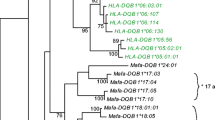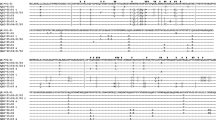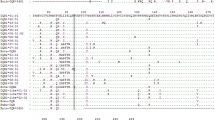Abstract
TheHLA-D region of the major histocompatibility complex (MHC) is characterized by a remarkable diversity. Most of theHLA class II genes are highly polymorphic, and in addition, the number and organization of individual loci in that region varies in different haplotypes. This extensive allelic polymorphism of immune response genes has well-known functional implications. Within theHLA-D region, two loci,DQA2 andDQB2 (formerly calledDXα andDXβ), represent a very special case: the detailed structure of these two genes is entirely compatible with expression, yet their expression has never been demonstrated in any tissue. Consequently, there exists no known corresponding protein product. Pseudogenes are known to accumulate mutations, as observed for instance in the case ofHLA-DPA2,-DPB2, or-DRB2 genes. We have therefore investigated the extent of DQ2 genes' polymorphism by DNA sequence comparison and by oligonucleotide hybridization across a large number of different haplotypes, and compared it with other genes in theHLA-D region. We show here that, contrary to the adjacentDQ1 genes,DQ2 genes exhibit little and possibly no polymorphism. This conservation ofDQ2 genes in many haplotypes indicates that the DQ 1-DQ2 duplication event must have preceeded the extensive diversification ofDQ1 genes and raises the puzzling question of whyDQ2 genes have remained nonpolymorphic. This suggests that either these genes correspond to an unusually invariant region of the MHC or they are under a strong selective pressure for the conservation of the amino acid sequence of a putative DQ2 gene product. The latter would imply that theHLA-DQ2 genes are expressed into a protein product endowed with essential functional properties.
Similar content being viewed by others
References
Andersson, G., Larhammar, D., Widmark, E., Servenius, B., Peterson, P. A., and Rask, L.: Class II genes of the human major histocompatibility complex: organization and evolutionary relationship of the DRβ genes.J Biol Chem 262: 8748–8758, 1987
Angelini, G., de Préval, C., Gorski, J., and Mach, B.: High-resolution analysis of the human HLA-DR polymorphism by hybridization with sequence-specific oligonucleotide probes.Proc Natl Acad Sci USA 83: 4489–4493, 1986
Auffray, C., Lillie, J. W., Korman, A. J., Boss, J. M., Fréchin, N., Guillemot, F., Cooper, J., Mulligan, R. C., and Strominger, J. L.: Structure and expression ofHLA-DQα andDXα genes: interallelic alternate splicing of theHLA-DQα gene and functional splicing of theHLA-DXα gene using a retroviral vector.Immunogenetics 26: 63–73, 1987
Benton, W. D., and Davis, R. W.: Screening λgt reecombinant clones by hybridization of single plaques in situ.Science 196: 180–182, 1977
Berdoz, J., Gorski, J., Termijtelen, A. M., Dayer, J. M., Irlé, C., Schendel, D., and Mach, B.: Constitutive and induced expression of the individual HLA-DRβ andα chain loci in different cell types.J Immunol 139: 1336–1341, 1987
Bidwell, J. L., Bidwell, E. A., Laundry, G. J., Klouda, P. T., and Bradley, B. A.: Allogenotype defined by short DQα and DQβ cDNA probes correlated with and define splits of HLA-DQ serological specificities.Mol Immunol 24: 513–522, 1987
Böhme, J., Andersson, M., Andersson, G., Möller, E., Peterson, P. A., and Rask, L.: HLA-DRβ genes vary in number between different DR specifities, whereas the number of DQβ genes is constant.J Immunol 135: 2149–2155 1985
Buus, S., Sette, A., Colon, S. M., Miles, C., and Grey, H. M.: The relation between major histocompatibility complex (MHC) restriction and the capacity of Ia to bind immunogenic peptides.Science 235: 1353–1358 1987
Chomczynski, P. and Qasba, P. K.: Alkaline transfer of DNA to plastic membrane.Biochem Biophys Res Commun 122: 340–344, 1984
Collins, T., Korman, A. J., Wake, C. T., Boss, J., Kappes, D. J., Fiers, W., Ault, K. A., Gimbrone, M. A., Strominger, J. L., and Pober, J. S.: Immune interferon activates multiple class II major histocompatibility comple genes and the associated invariant chain gene in human endothelial cells and dermal fibroblasts.Proc Natl Acad Sci USA 81: 4917–4921, 1984
Feinberg, A. P. and Vogelstein, B.: A technique for radiolabeling DNA restriction endonuclease fragments to high specific activity.Anal Biochem 132: 6–13, 1983
Feinberg, A. P. and Vogelstein, B.: Addendum: a technique for radiolabeling DNA restriction endonuclease fragments to high specific activity.Anal Biochem 137: 266–267, 1984
Gorski, J., and Mach, B.: Polymorphism of human Ia antigens: gene conversion between two DRß loci results in a new HLA-D/DR specificity.Nature 322: 266–267, 1986
Gorski, J., Rollini, P., Kawashima, E., Long, E. O., and Mach, B.: Multiplicity of human class IIß chain genes.In E. Sercaz, H. Cantor, and L. Chess (eds.)Regulation of the Immune System, UCLA Symposia on Molecular and Cellular Biology, 18: 47–56, A. R. Liss, Inc., New York, 1984
Gorski, J., Rollini, P., and Mach, B.: Structural comparison of the genes of two HLA-DR supertypic groups: the loci encoding DRw52 and DRw53 are not truly allelic,Immunogenetics 25: 397–402, 1987
Gross-Bellard, M., Oudet, P., and Chambon, P.: Isolation of high molecular weight DNA from mammalian cells.Eur J Biochem 36: 32–38, 1973
Gustafsson, K., Widmark, E., Jonsson, A. K., Servenius, B., Sachs, D. H., Larhammar, D., Rask, L., and Peterson, P. A.: Class II genes of the human major histocompatibility complex: evolution of the DP region as deduced from nucleotide sequences of the four genes.J Biol Chem 262: 8778–8786, 1987
Hardy, D. A., Bell, J. I., Long, E. O., Lindsten, T., and McDevitt, H. O.: Mapping of the class II region of the human major histocompatibility complex by pulsed-field electrophoresis.Nature 323: 453–455, 1986
Hohn, B. and Murray, K.: Packaging recombinant DNA molecules into bacteriophage particles in vitro.Proc Natl Acad Sci USA 74: 3259–3263, 1979
Jonsson, A. K., Hyldig-Nielsen, J. J., Servenius, B., Larhammar, D., Andersson, G., Jörgensen, F., Peterson, P. A., and Rask, L.: Class II genes of the human major histocompatibility complex: comparison of the DQ and DXα andβ genes.J Biol Chem 262: 8767–8777, 1987
Kappes, D. J., Arnot, D., Okada, K., and Strominger, J. L.: Structure and polymorphism of the HLA class II SB light chain genes.EMBO J 3: 2985–2993, 1984
Korman, A. J., Boss, J. M., Spies, T., Sorentino, R., Okada, K., and Strominger, J. L.: Genetic complexity and expression of human class II histocompatibility antigens.Immunol Rev 85: 45–86, 1985
Long, E. O., Gorski, J., Rollini, P., Wake, C. T., Strubin, M., Rabourdin-Combe, C., and Mach, B.: Molecular analysis of the genes for human class II antigens of the major histocompatibility complex.Hum Immunol 8: 113–121, 1983
Mach, B., Gorski, J., Rollini, P., Berte, C., Amaldi, I., Berdoz, J., and Ucla, C.: Polymorphism and regulation of HLA class II genes of the major histocompatibility complex.Cold Spring Harbor Symp Quant Biol 51: 67–74, 1986
MacMurray, A. J., Bell, J. I., Denney, D., Watling, D., Foster, L. S., and McDevitt, H. O.: Molecular mapping class II polymorphisms in the human major histocompatibility complex: II. DQβ.J Immunol 139: 574–586, 1987
Okada, K., Boss, J. M., Prentice, H., Spies, T., Mengler, R., Auffray, C., Lillie, J., Grossberger, D., and Strominger, J. L.: Gene organization of DC and DX subregions of the human major histocompatibility complex.Proc Natl Acad Sci USA 82: 3410–3414, 1985a
Okada, K., Prentice, H. L., Boss, J. M., Levy, D. J., Kappes, D., Spies, T., Raghupathy, R., Mengler, R. A., Auffray, C., and Strominger, J. L.: SB subregion of the human major histocompatibility complex: gene organization, allelic polymorphism and expression in transformed cells.EMBO J 4: 739–748, 1985b
Rask, L., Gustafsson, K., Larhammar, D., Ronne, H., and Peterson, P. A.: Generation of clas II antigen polymorphism.Immunol Rev 84: 123–143, 1985
Rimms, D., Horness, D., Kucera, J., and Blattner, F.: Construction of coliphage lambda Charon vectors with BamHI cloning sites.Gene 12: 301–305, 1980
Rollini, P., Mach, B., and Gorski, J.: Linkage map of three HLA-DRβ chain genes: evidence for a recent duplication event.Proc Natl Acad Sci USA 82: 7197–7201, 1985
Rollini, P., Mach, B., and Gorski, J.: Characterization of anHLA-DRβ pseudogene in the DRw52 supertypic group.Immunogenetics 25: 336–342, 1987
Rosenshine, S., Cascino, I., Zeevi, A., Duquesnoy, R. J., and Trucco, M.: DQα andβ RFLP reveals the composition of the DQ molecule recognized by T-cell clones.Immunogenetics 23: 187–196, 1986
Sanger, F., Nicklen, S., and Coulsen, A. R.: DNA sequencing with chain terminating inhibitors.Proc Natl Acad Sci USA 74: 5463–5467, 1977
Schwartz, R. H.: T-lymphocyte recognition of antigen in association with gene products of the major histocompatibility complex.Annu Rev Immunol 3: 237–261, 1985
Sgaramella, V., and Khorana, H. G.: Total synthesis of the structural gene for an alanine trasnfer RNA from yeast. Enzymic joining of the chemically synthesized polydeoxynucleotides to form the DNA duplex representing nucleotide sequence 1 to 20.J Mol Biol 72: 427–444, 1972
Spielman, R.S., Lee, J., Bodmer, W.F., Bodmer, J.G., and Trowsdale, J.: Six HLA-D region α chain genes on human chromosome 6: polymorphisms and associations of DC α-related sequences with DR types.Proc Natl Acad Sci USA 81: 3461–3465, 1984
Steinmetz, M., Malissen, M., Hood, L., Orn, A., Maki, R.A., Dastoornikoo, G.R., Stephan, D., Gibb, E., and Romaniuk, R.: Tracts of high or low sequence divergence in the mouse major histocompatibility complex.EMBO J 3: 2995–3003, 1984
Trowsdale, J., Young, J.A.T., Kelly, A.P., Austin, P.J., Carson, S., Meunier, H., So, A., Erlich, H.A., Spielman, R.S., Bodmer, J., and Bodmer, W.F.: Structure, sequence and polymorphism in the HLA-D region.Immunol Rev 85: 5–43, 1985
Trucco, M., Rosenshine, S., Cascino, I., and Duquesnoy, R.J.: HLA-DQ polymorphism analyzed by sequential restriction endonuclease DNA digestion.Immunogenetics 24: 184–190, 1986
Author information
Authors and Affiliations
Rights and permissions
About this article
Cite this article
Berdoz, J., Tiercy, JM., Rollini, P. et al. Remarkable sequence conservation of theHLA-DQB2 locus (DXβ) within the highly polymorphicDQ subregion of the human MHC. Immunogenetics 29, 241–248 (1989). https://doi.org/10.1007/BF00717908
Received:
Revised:
Issue Date:
DOI: https://doi.org/10.1007/BF00717908




